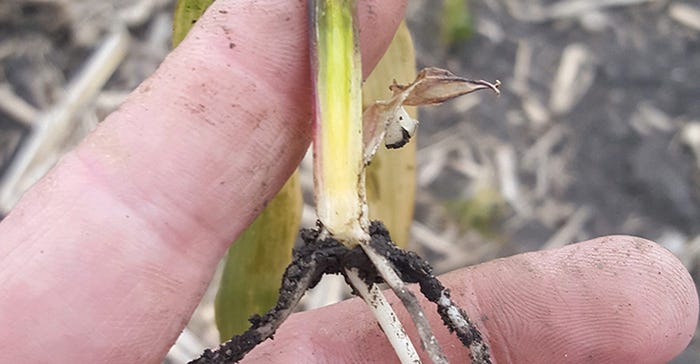April 1, 2021

Sponsored Content
Early-season frost damage is a stressful physiological event that can slow plant development. The net impact of early-season frost will depend on the health of the plant before the frost, the extent and duration of the freezing temperatures, and the growing environment following the frost.
In general, corn seedlings are at a lower risk of death from freezing temperatures than soybeans because the growing point of corn remains below ground later in the spring until the V5 to V6 growth stage.
Where to Look:
Low-lying areas. Even a one-to-two-foot depression is more vulnerable to frost.
High residue. Residue slows the springtime soil warming processes.
Dry, loose soils. They tend to lose heat more rapidly than moist or compacted soils.
Freeze Damage on Plant Tissue:
Water within the leaf freezes, rupturing cells.
CORN
Frost will not kill corn plants unless temperatures drop low enough to drive the cold into the soil and kill the growing point that is positioned .75 in. below the soil surface. Corn that has not emerged is typically well insulated from frost damage.
Most Vulnerable:
Recently emerged or early vegetative growth with tender leaves
Any time air temperatures dip below 32°F for extended periods of time
Symptoms:
Show up one to two days after the freeze event
Water-soaked leaves
Leaves turn limp and brown
Three to four days later, new green leaves will emerge from the whorl



Check for Long-Term Damage:
If, after three or four days, new leaves are not visible or emerging, check the growing point for discoloration. Carefully dig the young plant from the soil and split the plant lengthwise to observe the growing point. Healthy tissue will be white, cream, or light yellow in color – any other color indicates that the growing point is damaged. A common complication of a strong frost/light freeze at the V2 to V3 growth stage in corn is that the leaf-tips get “tied-up” and further restrict new leaf emergence. Under subsequent cloudy, cool, and moist conditions, visual recovery can take seven to ten days.
SOYBEANS
Although subject to frost as well, soybeans often escape similar injury due to plant development and planting dates past the average last frost date.
Upon emergence, the growing point of a soybean plant is above the soil surface and less insulated against frost. Soybean cotyledons are thick compared to the leaves. Therefore, cotyledon stage soybeans are more tolerant to freezing temperatures than older soybean or young corn leaves. When the frost only affects the top of the soybean plant, those plants with one or more cotyledons intact will recover from surviving axillary buds.
Most Vulnerable:
If the air temperature stays at or below 28 to 30°F for several hours
Hooking stage soybeans will be killed if the hypocotyl tissue below the cotyledons is killed
Symptoms:
Water-soaked lesions on the cotyledons, leaves or hypocotyl
Check for Long-Term Damage:
Check for firm and healthy hypocotyls, cotyledons, and growing points. In soybeans, the growing points are above ground at emergence and are exposed after the cotyledons open. Freezing of all growing points is fatal. However, soybeans can compensate better for partial stand losses than corn.
MANAGEMENT MOVING FORWARD
Frost damage is often visible immediately. Assess damage three or four days after the frost event when plants have had an opportunity to show new growth. If a significant portion of the stand is not showing signs of recovery, you may need to consider replant. Your local Beck’s representative can provide you with more information on how to evaluate a stand to determine if replant is necessary and about Beck’s 100% Free Replant Policy.
Early frost can have an impact on grain yield, but the trade-off between planting date’s impact on yield is generally greater than that of frost damages. Delayed planting further impacts profitability due to management delays, higher harvest moisture, and increased drying costs with corn.
Beck’s is the largest family-owned retail seed company in the United States that serves farmers in Arkansas, Illinois, Indiana, Iowa, Kansas, Kentucky, Michigan, Minnesota, Mississippi, Missouri, Ohio, South Dakota, Tennessee, and Wisconsin. According to a recent seed industry survey, Beck’s ranks as the third largest corn and soybean brand in the United States. At their core, all Beck’s employees are Farmers at Heart. It stands for something special. It has soul. It has truth. And it represents a community of farmers, employees, and dealers who strive each day to seek challenges, push boundaries and innovate. Beck’s has, and always will be, proud to serve a community of farmers who love what they do and who are proud to be… Farmers at Heart. For more agronomic new and information, visit Beck’s Agronomy Talk page or blog at BecksHybrids.com.
About the Author(s)
You May Also Like




